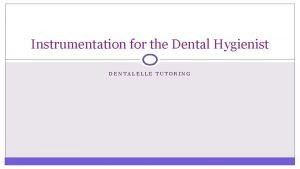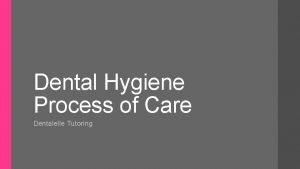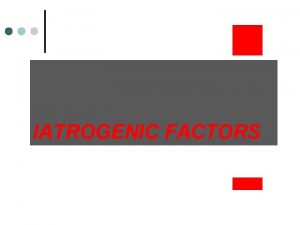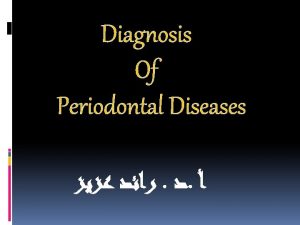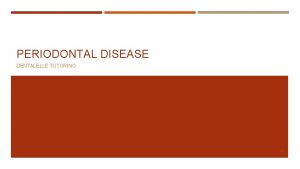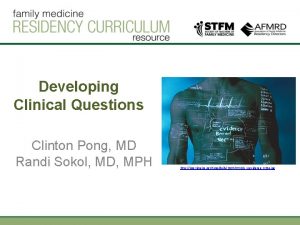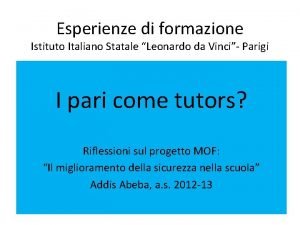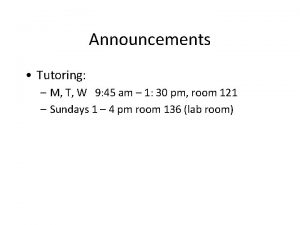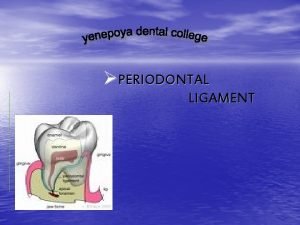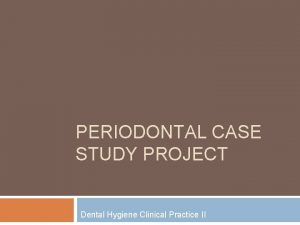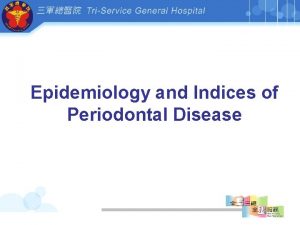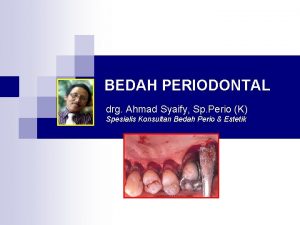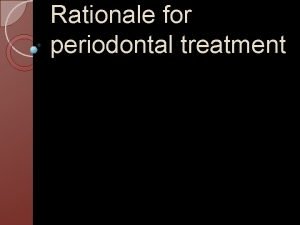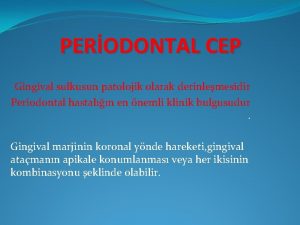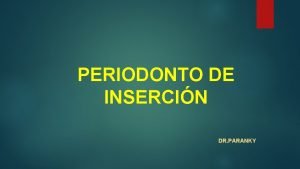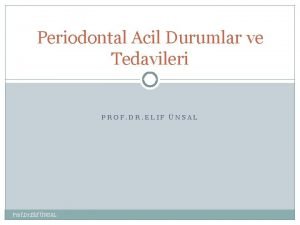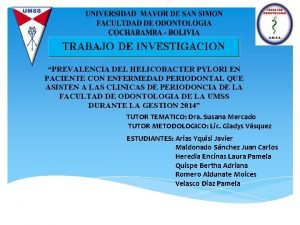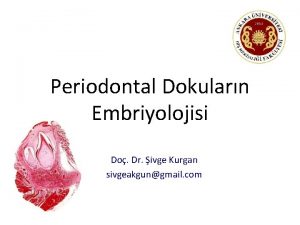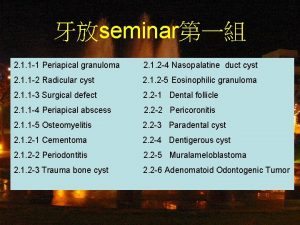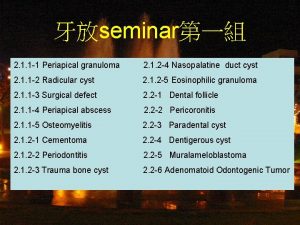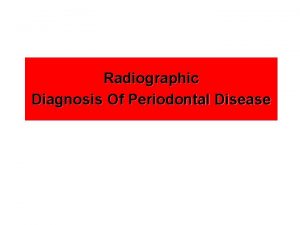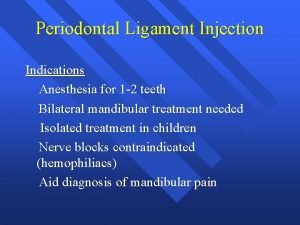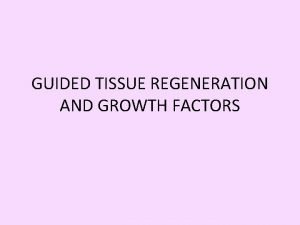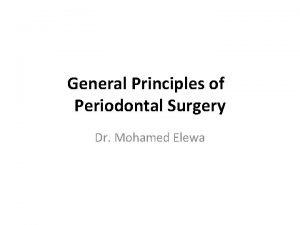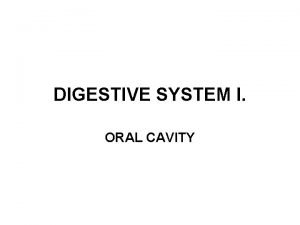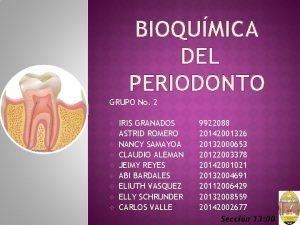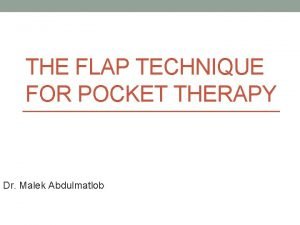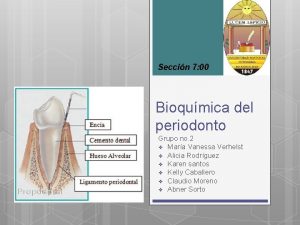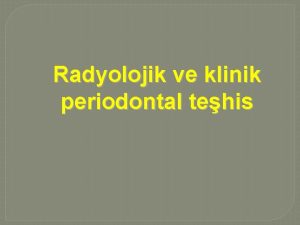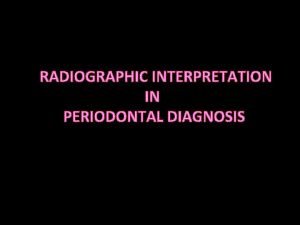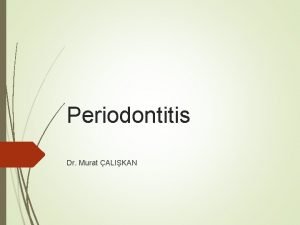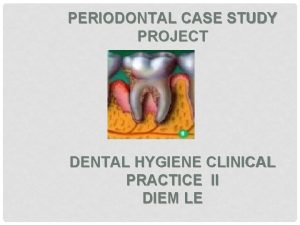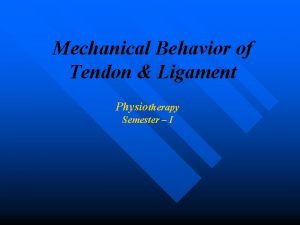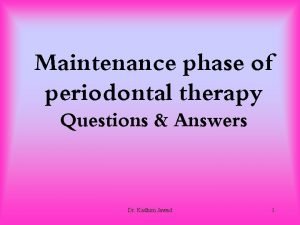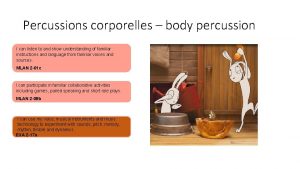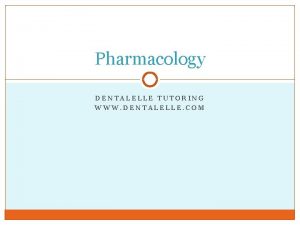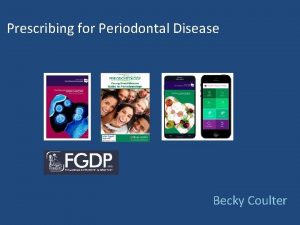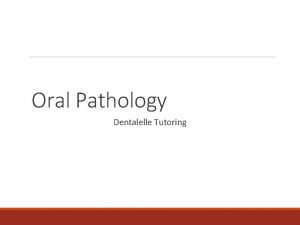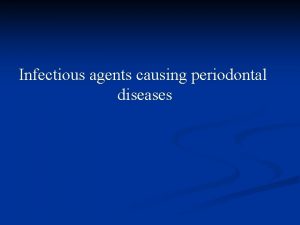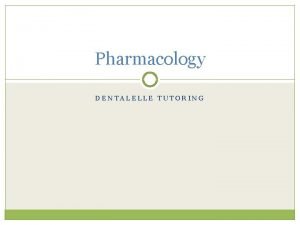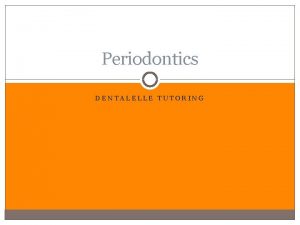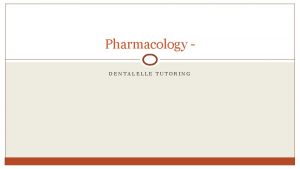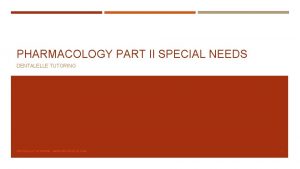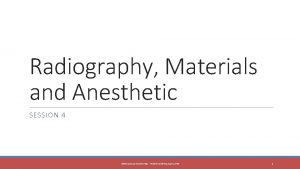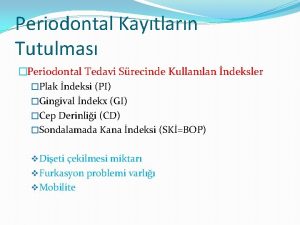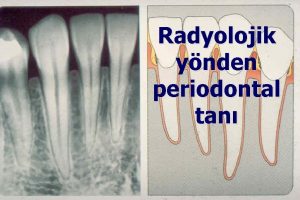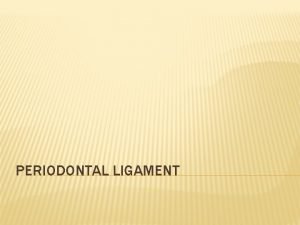PERIODONTAL DISEASE DENTALELLE TUTORING 1 QUESTION Can everyone

































































































- Slides: 97

PERIODONTAL DISEASE DENTALELLE TUTORING 1

QUESTION Can everyone see and hear me OK? If you can’t – please text technical support at 519859 -4908 2

CHARACTERISTICS Color Healthy gingiva usually has a color that has been described as "coral pink. " Other colours like red, white, and blue can signify inflammation (gingivitis) or pathology. Although described as the colour coral pink, variation in colour is possible. This can be the result of factors such as: thickness and degree of keratinization of the epithelium, blood flow to the gingiva, natural pigmentation, disease and medications. Since the colour of the gingiva can vary, uniformity of colour is more important than the underlying color itself. Excess deposits of melanin cause dark spots or patches on the gums (melanin gingival hyperpigmentation), especially at the base of the interdental papillae. Example of colors – red, pink, cyanotic Contour Healthy gingiva has a smooth arcuate or scalloped appearance around each tooth. Healthy gingiva fills and fits each interdental space, unlike the swollen gingiva papilla seen in gingivitis or the empty interdental embrasure seen in periodontal disease. Healthy gums hold tight to each tooth in that the gingival surface narrows to "knife-edge" thin at the free gingival margin. On the other hand, inflamed gums have a "puffy" or "rolled" margin. Example of contours – bulbous, punched-out, flattened, cratered 3

CONTINUED Texture Healthy gingiva has a firm texture that is resistant to movement, and the surface texture often exhibits surface stippling. Unhealthy gingiva, on the other hand, is often swollen and less firm. Healthy gingiva has an orange-peel like texture to it due to the stippling. Examples of texture – smooth, shiny, eroded, stippling Consistency How the gingiva feels – healthy gingiva should be firm Examples of consistency – firm (fibrotic), spongy (edematous) Reaction to disturbance Healthy gums usually have no reaction to normal disturbance such as brushing or periodontal probing. Unhealthy gums, conversely, will show bleeding on probing (BOP) and/or purulent exudate 4

TERMS TO BE USED You need to determine the location, distribution and severity Location – generalized or localized Distribution – diffuse, marginal or papillary Severity - Slight, moderate, severe 5

GINGIVITS Gingivitis is the mildest form of periodontal disease (gingivitis is NOT perio it CAN lead to perio if not treated). . It causes the gums to become red, swollen, and bleed easily. There is usually little or no discomfort at this stage. Gingivitis is often caused by inadequate oral hygiene. Gingivitis is reversible with professional treatment and good oral home care. Factors that may contribute to gingivitis include, diabetes, smoking, aging, genetic predisposition, systemic diseases and conditions, stress, inadequate nutrition, puberty, hormonal fluctuations, pregnancy, substance abuse, HIV infection, and certain medication use. 6

RISK FACTORS AGE Studies indicate that older people have the highest rates of periodontal disease. Data from the Centers for Disease Control and Prevention indicates that over 70% of Americans 65 and older have periodontitis. SMOKING/TOBACCO USE Tobacco use is linked with many serious illnesses such as cancer, lung disease and heart disease, as well as numerous other health problems. Tobacco users also are at increased risk for periodontal disease. Studies have shown that tobacco use may be one of the most significant risk factors in the development and progression of periodontal disease. GENETICS Research has indicated that some people may be genetically susceptible to gum disease. Despite aggressive oral care habits, these people may be more likely to develop periodontal disease. Identifying these people with a genetic test before they even show signs of the disease and getting them into early intervention treatment may help them keep their teeth for a lifetime. STRESS Stress is linked to many serious conditions such as hypertension, cancer, and numerous other health problems. Stress also is a risk factor for periodontal disease. Research demonstrates that stress can make it more difficult for the body to fight off infection, including periodontal diseases. 7

CONTINUED MEDICATIONS Some drugs, such as oral contraceptives, anti-depressants, and certain heart medicines, can affect your oral health. Just as you notify your pharmacist and other health care providers of all medicines you are taking and any changes in your overall health, you should also inform your dental care provider. CLENCHING OR GRINDING YOUR TEETH Clenching or grinding your teeth can put excess force on the supporting tissues of the teeth and could speed up the rate at which these periodontal tissues are destroyed. OTHER SYSTEMIC DISEASES Other systemic diseases that interfere with the body's inflammatory system may worsen the condition of the gums. These include cardiovascular disease, diabetes, and rheumatoid arthritis. POOR NUTRITION AND OBESITY A diet low in important nutrients can compromise the body's immune system and make it harder for the body to fight off infection. Because periodontal disease begins as an infection, poor nutrition can worsen the condition of your gums. In addition, research has shown that obesity may increase the risk of periodontal disease. 8

THE PERIODONTIUM AB, alveolar bone; AC, alveolatrcrest; AM, alveolar mucosa; AP, alveolar process; CB, compact bone of alveolar bone proper; CEJ, cemento-enamel junction; CT, connective tissue; DEJ, dentino-enamel junction; ES, enamel space; G, gingiva; GE, gingival epithelium; GG, gingival groove; GM, gingival margin; GS, gingival sulcus; JE, junctional epithelium; MGJ, mucogingival junction; MS, marrow space; OE, oral epithelium; PDL, periodontal ligament; RCE, radicular (root) cementum; SE, sulcular epithelium; 9

THE GINGIVA Clinicians sometime use the terms "free" and "attached" gingiva. Although these terms may have some clinical relevance, they are anatomically incorrect. The determination as to whether the gingiva is "free" or "attached" is made by probing the gingival sulcus with a periodontal probe. This instrument will frequently penetrate the junctional epithelium beyond the sulcus bottom, particularly in the presence of inflammation. This results in the clinical impression that the marginal gingiva is detached from the tooth to a much greater degree than is the case. Anatomically. "Attached" gingiva refers to the portion of the gingiva apical to the "free" gingiva which is firmly bound to the underlying tooth and alveolar process. 10

DIAGRAM 11

FIBER GROUPS These are largely composed of collagenous fibers. The dentogingival fibers (A) insert into the supracrestal root cementum and fan out into the adjacent connective tissue. The dentoperiosteal fibers (B) insert into the supracrestal root cementum and blend with the periosteal covering of the adjacent alveolar process. The alveologingival fibers (C) insert into the alveolar crest and fan out into the adjacent gingival connective tissue. The circumferential fibers (D) follow a circular course around individual dental units. The semicircular fibers (E) insert on the approximal surfaces of a tooth and follow a semicircular course to insert on the opposite side of the same tooth. The transgingival fibers (F) insert into the approximal surface of a tooth and fan out toward the oral or vestibular surface. The intergingival (G) fibers course along the oral or vestibular surfaces of the dental arch. The transseptal fibers (H) course from one approximal tooth surface to the approximal surface of the adjacent tooth. 12

13

VESSELS AND NERVES (i) Blood supply: The gingival blood supply originates from blood vessels in the periodontal ligament, the marrow spaces of the alveolar process and supraperiosteal blood vessels. These vessels in turn supply major capillary plexuses that are located in the connective tissue adjacent to the oral epithelium and the junctional epithelium. (ii) Lymphatics: The gingival tissues are supplied with lymphatic vessels that drain principally to submaxillary lymph nodes. (iii) Nerves: Branches of the trigeminal nerve provide sensory and proprioceptive functions. In addition, autonomic nerve endings are associated with the vasculature. 14

PERIODONTAL LIGAMENT 15

SUPPORTIVE The periodontal ligament serves primarily a supportive function by attaching the tooth to the surrounding alveolar bone proper. This function is mediated primarily by the principal fibers of the periodontal ligament that form a strong fibrous union between the root cementum and the bone. The periodontal ligament also serves as a shock-absorber by mechanisms that provide resistance to light as well as heavy forces. Light forces are cushioned by intravascular fluid that is forced out of the blood vessels. Moderate forces are also absorbed by extravascular tissue fluid that is forced out of the periodontal ligament space into the adjacent marrow spaces. The heavier forces are taken up by the principal fibers. 16

REMODELING The periodontal ligament also serves a major remodeling function by providing cells that are able to form as well as resorb all the tissues that make up the attachment apparatus, i. e. bone, cementum and the periodontal ligament Undifferentiated ectomesenchymal cells, located around blood vessels, can differentiate into the specialized cells that form bone (osteoblasts), cementum (cementoblasts), and connective tissue fibers (fibroblasts). Bone- and tooth-resorbing cells (osteoclasts and odontoclasts) are generally multinucleated cells derived from blood-borne macrophages. *B = BUILDING, OSTEOBLASTS *C = TAKING AWAY BONE - OSTEOCLASTS 17

SENSORY AND NUTRITIVE The periodontal ligament also serves a sensory function. The myelinated dental nerves that perforate the fundus of the alveoli rapidly lose their myelinated sheath as they branch to supply both the pulp and periodontal ligament. The periodontal ligament is richly supplied with nerve endings that are primarily receptors for pain and pressure. Finally, the periodontal ligament provides a nutritive function that maintains the vitality of its various cells. The ligament is well-vascularized, with the major blood supply originating from the dental arteries that enter the ligament through the fundus of the alveoli. Major anastomoses exist between blood vessels in the adjacent marrow spaces and the gingiva. 18

CEMENTUM 19

CEMENTUM Cementum may be found both on the root as well as the crowns of teeth. It may also vary in its structure. Some forms of cementum may be cellular, while others are not. Some have a fibrillar collagenous matrix, while others do not. Cementum may be classified in the following ways: Radicular cementum: The cementum that is found on the root surface. Coronal cementum: The cementum that forms on the enamel covering the crown. Cellular cementum: Cementum containing cementocytes in lacunae within the cementum matrix. Acellular cementum: Cementum without any cells in its matrix. Fibrillar cementum: Cementum with a matrix that contains well-defined fibrils of type I collagen. Afibrillar cementum: Cementum that has a matrix devoid of detectable type I collagen fibrils. Instead, the matrix tends to have a fine, granular consistency. 20

TYPES 1. Acellular, afibrillar cementum This cementum is mostly composed of mineralized matrix, without detectable collagen fibrils or cementocytes. It is produced exclusively by cementoblasts. It is typically found as coronal cementum on human teeth. 2. Acellular, extrinsic fiber cementum This type of cementum has a matrix of well-defined, type I collagen fibrils. The fibrils are part of the, densely packed Sharpey's fibers, that are continuous with the principal fibers of the periodontal ligament. Because of their dense packing, the individual Sharpey's fibers that form the bulk of the matrix may no longer be identifiable as individual fibers within the cementum layer. This cementum, which is acellular, is located in the cervical two-thirds of the root of human teeth. It plays a major role in tooth anchorage. 21

3. Cellular, intrinsic fiber cementum This cementum contains cementocytes in a matrix composed almost exclusively of intrinsic fiber cementum. It is located almost exclusively at sites of cementum repair. It plays no part in tooth anchorage. However, it may be covered over by extrinsic or mixed fiber cementum, both of which are able to provide new anchorage. 4. Cellular, mixed fiber cementum It is found on the apical third of the root and in furcations (i. e. between roots). In these locations, the rate of cementum formation is usually more rapid than in the cervical region. The mineralized, extrinsic collagen fibers (Sharpey's fibers) run a more irregular course than in acellular, extrinsic fiber cementum. Intrinsic fibers are found interspersed among the extrinsic fibers of the cementum matrix, so that individual Sharpey’s fibers are more readily identifiable than in extrinsic fiber cementum. Cementoblasts are trapped in hollow chambers (or lacunae) where they become cementocytes. The thickness of radicular cementum increases with age. It is thicker apically than cervically. Thickness may range from 0. 05 to 0. 6 mm. 22

BONE 23

GENERAL The alveolar process is the portion of the jawbone that contains the teeth and the alveoli in which they are suspended. The alveolar process rests on basal bone. Proper development of the alveolar process is dependent on tooth eruption and its maintenance on tooth retention. When teeth fail to develop (e. g. anodontia), the alveolar process fails to form. When all teeth are extracted, most of the alveolar process becomes involuted, leaving basal bone as the major constituent of the jawbone. The remaining jawbone, therefore, is much reduced in height. The alveolar process is composed of an outer and inner cortical plate of compact bone that enclose the spongiosa, a compartment composed of spongy bone ( also called trabecular or cancellous bone). It is important to distinguish between the terms "alveolar process" and "alveolar bone". 24

ALVEOLAR BONE/ALVEOLAR PROCESS The alveolar bone proper lines the alveolus (or tooth housing) which is contained within the alveolar process. It is composed of a thin plate of cortical bone with numerous perforations ( or cribriform plate) that allow the passage of blood vessels between the bone marrow spaces and the periodontal ligament. The coronal rim of the alveolar bone forms the alveolar crest, which generally parallels the cemento- enamel junction at a distance of 1 -2 mm apical to it 25

FENESTRATION Where roots are prominent and the overlying bone very thin, the bone may actually resorb locally, creating a window in the bone through which the root can be seen. This window-like defect in the bone is referred to as a fenestration (F) 26

DEHISCENCE In some cases, as shown in this figure, the rim of bone between the fenestration and the alveolar crest may disappear altogether and produce a defect known as a dehiscence (D). Awareness of these defects is important when surgical flaps are reflected, as the exposure of such defects during surgery may aggravate their severity. 27

BONE FORMATION Bone is produced by osteoblasts (OB) that are found in the periosteum, endosteum and periodontal ligament adjacent to bone-forming surfaces. These specialized cells originate from less differentiated precursor cells close to the bone. These cells are in turn derived from undifferentiated ectomesenchymal cells found in the periosteum, endosteum and the periodontal ligament. During bone formation, osteoblasts become incorporated into bone as osteocytes (OC) that are completely surrounded by bone. The chamber in which they are trapped is called a lacuna (plur. lacunae). Osteocytes remain connected to osteoblasts and other osteocytes by cytoplasmic processes that run through small canals in the bone, or canaliculi (C). 28

OSTEON Cortical plate of compact bone in the mandible. The mandible is enveloped by a well-developed cortex of compact bone. The bulk of the compact bone consists of cylindrical units of bone, the osteons or Haversian systems (HS). Each osteon has a central canal, the Haversian canal that houses a blood vessel. Haversian canals are linked to one another and the periphery of the cortex by Volkman canals that course perpendicularly to the Haversian canals. The outer and inner layers of the cortex consist of parallel lamellae of compact bone, called the external (ECL) and internal circumferential lamellae. The bone that fills the spaces between adjacent osteons is the interstitial bone. 29

PERIODONTAL DISEASE Untreated gingivitis can advance to periodontitis. With time, plaque can spread and grow below the gum line. Toxins produced by the bacteria in plaque irritate the gums. The toxins stimulate a chronic inflammatory response in which the body in essence turns on itself, and the tissues and bone that support the teeth are broken down and destroyed. Gums separate from the teeth, forming pockets (spaces between the teeth and gums) that become infected. As the disease progresses, the pockets deepen and more gum tissue and bone are destroyed. Often, this destructive process has very mild symptoms. Eventually, teeth can become loose and may have to be removed. 30

A FEW FORMS: Aggressive periodontitis occurs in patients who are otherwise clinically healthy. Common features include rapid attachment loss and bone destruction and familial aggregation. Chronic periodontitis results in inflammation within the supporting tissues of the teeth, progressive attachment and bone loss. This is the most frequently occurring form of periodontitis and is characterized by pocket formation and/or recession of the gingiva. It is prevalent in adults, but can occur at any age. Progression of attachment loss usually occurs slowly, but periods of rapid progression can occur. Periodontitis as a manifestation of systemic diseases often begins at a young age. Systemic conditions such as heart disease, respiratory disease, and diabetes are associated with this form of periodontitis. Necrotizing periodontal disease is an infection characterized by necrosis of gingival tissues, periodontal ligament and alveolar bone. These lesions are most commonly observed in individuals with systemic conditions such as HIV infection, malnutrition and immunosuppression 31

DIABETES AND PERIODONTAL DISEASE Diabetic patients are more likely to develop periodontal disease, which in turn can increase blood sugar and diabetic complications. People with diabetes are more likely to have periodontal disease than people without diabetes, probably because people with diabetes are more susceptible to contracting infections. In fact, periodontal disease is often considered a complication of diabetes. Those people who don't have their diabetes under control are especially at risk. Research has suggested that the relationship between diabetes and periodontal disease goes both ways - periodontal disease may make it more difficult for people who have diabetes to control their blood sugar. Severe periodontal disease can increase blood sugar, contributing to increased periods of time when the body functions with a high blood sugar. This puts people with diabetes at increased risk for diabetic complications. 32

GUM DISEASE AND STROKE Several studies have shown that periodontal disease is associated with heart disease. While a cause-and-effect relationship has not yet been proven, research has indicated that periodontal disease increases the risk of heart disease. Scientists believe that inflammation caused by periodontal disease may be responsible for the association. Periodontal disease can also exacerbate existing heart conditions. Patients at risk for infective endocarditis may require antibiotics prior to dental procedures. Your periodontist and cardiologist will be able to determine if your heart condition requires use of antibiotics prior to dental procedures. STROKE Additional studies have pointed to a relationship between periodontal disease and stroke. In one study that looked at the causal relationship of oral infection as a risk factor for stroke, people diagnosed with acute cerebrovascular ischemia were found more likely to have an oral infection when compared to those in the control group. 33

WOMEN PUBERTY During puberty, an increased level of sex hormones, such as progesterone and possibly estrogen, causes increased blood circulation to the gums. This may cause an increase in the gum's sensitivity and lead to a greater reaction to any irritation, including food particles and plaque. During this time, the gums may become swollen, turn red and feel tender. MENSTRUATION Occasionally, some women experience menstruation gingivitis. Women with this condition may experience bleeding gums, bright red and swollen gums and sores on the inside of the cheek. Menstruation gingivitis typically occurs right before a woman's period and clears up once her period has started. PREGNANCY Some studies have suggested the possibility of an additional risk factor – periodontal disease. Pregnant women who have periodontal disease may be more likely to have a baby that is born too early and too small. However, more research is needed to confirm how periodontal disease may affect pregnancy outcomes. All infections are cause for concern among pregnant women because they pose a risk to the health of the baby. The Academy recommends that women considering pregnancy have a periodontal evaluation. MENOPAUSE AND POST-MENOPAUSE Women who are menopausal or post-menopausal may experience changes in their mouths. They may notice discomfort in the mouth, including dry mouth, pain and burning sensations in the gum tissue and altered taste, especially salty, peppery or sour. In addition, menopausal gingivostomatitis affects a small percentage of women. Gums that look dry or shiny, bleed easily and range from abnormally pale to deep red mark this condition. Most women find that estrogen supplements help to relieve these symptoms. 34

PERIODONTAL DISEASE 35

CHRONIC PERIODONTAL DISEASE Chronic periodontitis (a. k. a. adult periodontitis) is the most frequent type of periodontitis and is characterized by pocket formation and slowly progressing gum recession. The condition may first appear in adolescence due to poor oral hygiene but in most cases it is after mid- 30 s when the clinical symptoms become significant. If chronic periodontitis symptoms are ignored, the loss of bone and gum tissue will lead to tooth loss. It can be further divided into 3 stages; early, moderate and advanced stage. 36

EARLY PERIODONTAL DISEASE Periodontitis is the more dangerous form of periodontal disease. Infection and inflammation has spread to the bone supporting the teeth. When gum disease has progressed to the periodontitis stage, the supporting bone and fibers that hold the teeth in place start to get irreversibly damaged. The stages of periodontitis are defined as early, moderate, and advanced. The main factor for the classification to a certain stage of the disease is the degree of destruction of the supporting bone. In the initial stage of periodontitis plaque bacteria continue to penetrate deeper between the teeth and gums. The environment becomes suitable for the establishment of anaerobic bacteria under the gums. Gingival pockets are formed below the gumline. Greater inflammation and swelling of the gums Gums begin to separate from teeth below the cemento-enamel junction Gum bleeding when probing or brushing Pocket depth up to 4 mm Infection reaches bone - Slight bone loss Unpleasant breath or taste Subgingival accumulation of plaque and calculus Treatment of early periodontitis includes tooth scaling and root planing accompanied by improved oral hygiene. Despite the bone damage, the amount of bone loss in this stage of periodontal disease is minor so that usually no additional treatment is required. 37

MODERATE PERIODONTAL DISEASE The surrounding connective tissues and alveolar bone become are seriously infected. Bacterial toxins and the body's enzymes fighting the infection break down the bone and connective tissue that hold teeth in place. First signs of tooth mobility appear due to bone loss. Moderate Periodontitis Gums recession – teeth appear longer Root surface exposed - sensitivity - root decay Persistent bad breath Bleeding gums Pocket depth of 5 -6 mm Moderate bone loss (20 - 50%) Periodontal abscesses may develop Teeth may begin to loosen, drift and look separated Moderate periodontitis is one of the most critical stages of periodontal disease, because some ‘damage control’ is yet possible before the condition reaches a phase when teeth can not be saved. Surgical treatments of gum disease can stop the progress of the disease but the damage is not reversible. 38

ADVANCED PERIODONTITIS This final stage of periodontal disease is characterized by severe infection, loosening teeth and tooth loss. Constant bad breath and bad taste Spontaneous gums bleeding Sensitive teeth due to exposed roots Pocket depth over 7 mm Pus drainage in the mouth due to periodontal abscesses Severe bone loss (more than 50%) Teeth drifting out of place Teeth become loose or fall out Teeth become so mobile and the bone loss so severe that in many cases they can not be saved and have to be extracted. In other cases, teeth extraction is necessary in order to clear the infection. The advanced stage of periodontitis can be reached in some cases without intense visible alerting symptoms despite the severe underlying bone damage. Extensive periodontal gum surgery that includes soft and hard tissue grafting are necessary in a treatment effort to save the affected teeth. Unfortunately the prognosis is not good if the condition has reached to this advanced stages of periodontal disease. 39

AGGRESSIVE PERIODONTAL DISEASE Aggressive periodontitis (a. k. a. early onset periodontitis) is a dangerous type of periodontal disease that can cause tooth loss in a short period of time. Common symptoms are the fast increase in the depth of periodontal pockets and the rapid loss of bone structure. Sometimes the condition is localized affecting one or no more than 3 teeth in patients with good oral health. Generalized aggressive periodontitis affecting the whole mouth requires immediate treatment to prevent extensive tooth loss. Genetic factors and immune deficiencies are considered as causes of aggressive periodontitis in addition to the microbial etiology of gum disease. Depending on the age when the condition first appears it used to be classified as: Pre-puberty AP is a rare type of periodontal disease found in children less than 12 years old that can cause the loss of primary and/or permanent teeth. The disease is usually related to genetic disorders and may appear with the eruption of the first primary teeth. Juvenile periodontitis begins at puberty and is defined by severe bone loss commonly limited around the first molars and incisors. It is more aggressive than other types of periodontal disease causing very rapid vertical bone loss across the teeth roots. Juvenile periodontitis is usually asymptomatic without the usual symptoms of gum disease such as gums inflammation or gum bleeding. Rapidly progressive periodontitis occurs in the early 20 s to mid-30 s. Severe inflammation and rapid bone and connective tissue loss occur, and tooth loss is possible within a year of onset. The goal of treatment in aggressive periodontitis is to fight the microbial etiology and (if possible) the contributing risk factors. Treatment methods are similar to those used for chronic periodontitis, including oral hygiene, tooth scaling and root planing, and periodontal gum surgery if needed. 40

PERIO AND SYSTEMIC DISEASES Periodontitis as a manifestation of systemic diseases is more often associated with younger age patients. Systemic conditions such as heart disease, leukemia, respiratory disease, and diabetes or disorders such as Down syndrome are associated with this form of periodontal disease. A medical examination is required in cases of early-onset periodontitis to identify the presence of any systemic disease that might have triggered the periodontal disease. 41

ANUG Acute Necrotizing Ulcerative Gingivitis (ANUG) is a severe and painful type of periodontal disease, which causes deep ulcerations of the gingival tissues. The condition is usually triggered by poor oral hygiene and poor nutrition. If left without treatment, the bacterial infection can lead to the necrosis of gum tissues and may spread to other areas of the body. Acute Necrotizing Ulcerative Gingivitis is a much more severe condition than normal gingivitis, causing open gum sores and finally the death of the gum tissue. 42

CONTINUED Pregnancy gingivitis is one of the most common dental problems during pregnancy. The condition is directly associated with the hormonal changes in the body of pregnant women. Pericoronitis is a common dental problem of the gums in young adults at the age of 17 -24 when the wisdom teeth normally erupt (break through the gum) in the mouth. It is a painful inflammation caused by the infection of the soft gingival tissues (gums) over or around a partially erupted tooth, most often a wisdom tooth. Periodontal-endodontic lesions are another type of periodontitis that is related with infected hard tooth tissues except of the gums. In this condition an infection from a decayed tooth root may spread to the adjacent bone and gum tissues creating deep pockets around the tooth and leading to bone loss. Desquamative gingivitis - one of the most painful but rare types of periodontal disease is a condition called desquamative gingivitis. The outer layers of the gums separate from the underlying tissue and peel away, exposing the inner layers and causing acute pain. This type of gum is more common in women after menopause. 43

LOCAL ANTIBIOTIC THERAPY In this form of antimicrobial periodontal treatment the dentist places the antibiotic medication directly into the affected mouth tissues. The material dissolves slowly releasing a controlled dose of the antibiotic for a period of a few days. There are several types of local antibiotic therapy, including: Gel – A gel containing antibiotic is injected into periodontal pockets under the gums and sealed with a periodontal pack which is removed after 7 to 10 days along with any remaining gel. Atridox is such a gel containing doxycycline. Elyzol is a gel applied to the gum that is composed of metronidazole. Powder — The dentist places the antibiotic in the form of a powder under the gums. The powder dissolves in about three weeks. Chip - Chips containing antibiotic is placed under the gums and into the periodontal pockets. The chip dissolves over 7 to 10 days. Periochip is a small piece of gelatin filled with chlorhexidine. Actisite is a thread-like fiber similar to dental floss that contains tetracycline hydrochloride. Arestin contains tiny round particles with the antibiotic minocycline. 44

TETRACYCLINE Tetracycline administered as an adjunct to scaling and root planing has shown a pocket reduction greater than scaling and root planing alone. Mean pocket depth reductions were between 0. 2 mm and 0. 8 mm greater than scaling and root planing alone at six months (2. 2 mm to 3. 1 mm total reduction) in pockets 4 mm to 6 mm. Mean clinical attachment level gain at six months was 0. 04 mm to 0. 3 mm better than scaling alone (1. 06 mm to 1. 7 mm net gain). If surgical outcomes are included in the meta-analysis, then tetracycline with scaling and root planing with or without replaced flap surgery has a net attachment benefit over the intervention alone of 0. 41 mm with a P = 0. 003. 45

ABSCESSES OF THE PERIODONTIUM 46

TYPES Periodontitis related abscess: When acute infections originate from a biofilm ( in the deepened periodontal pocket) Non-Periodontitis related abscess: When the acute infections originate from another local source. eg. Foreign body impaction, alteration in root integrity 47

ACUTE The abscess develops in a short period of time and lasts for a few days or a week. An acute abscess often presents as a sudden onset of pain on biting and a deep throbbing pain in a tooth in which the patient has been tending to clench. The gingiva becomes red, swollen and tender. In the early stages, there is no fluctuation or pus discharge, but as the disease progresses, the pus and discharge from the gingival crevice become evident. Associated lymph node enlargement maybe present. 48

CHRONIC This is the condition that lasts for a long time and often develops slowly. In the chronic stages, a nasty taste and spontaneous bleeding may accompany discomfort. The adjacent tooth is tender to bite on and is sometimes mobile. Pus may be present as also may be discharges from the gingival crevice or from a sinus in the mucosa overlying the affected root. Pain is usually of low intensity. 49

RODS Streptococcus viridans is the most common isolate in the exudate of periodontal abscesses when aerobic techniques are used. It has been reported that the microorganisms that colonize the periodontal abscesses are primarily Gram negative anaerobic rods. Although they are not found in all cases of periodontal abscesses, high frequencies of Porphyromonas gingivalis, Prevotella intermedia, Fusobacterium nucleatum, Campylobacter rectus, and Capnocytophagaspp have been reported. 50

A. A? Actinobacillus actinomycetemcomitans is not usually detected. The disappearance of Porphyromonas gingivalis from the abscessed sites after treatment suggests a close association of this microorganism with abscess formation. Spirochetes have been found as the predominant cell type in periodontal abscesses when assessed by darkfield microscopy. Strains of Peptostreptococcus, Streptococcus milleri (S. anginosus and S. Inter medius), Bacteroides capillosus, Veillonella, B. fragilis, and Eikenella corrodens have also been isolated. Overall, studies have noted that the microbiotas found in abscesses are similar to those in deep periodontal pockets. 51

HOW TO CONFIRM AN ABSCESS Radiographs – There are several dental radiographical techniques which are available (periapicals, bitewings and OPG) that may reveal either a normal appearance of the interdental bone or evident bone loss, ranging from just a widening of the periodontal ligament space to pronounced bone loss involving most of the affected cases. Intra oral radiographs, like periapical and vertical bite-wing views, are used to assess marginal bone loss and the perapical condition of the tooth which is involved. A gutta percha point which is placed through the sinus might locate the source of the abscess. 52

VITALITY TEST The Pulp Vitality Test – The Pulp vitality test, like thermal or electrical tests, could be used to assess the vitality of the tooth and the subsequent ruling out of the concomitant pulpal infections. 53

MICROBIAL AND LAB TESTING Microbial Test Samples of pus from the sinus/ abscess or that which is expressed from the gingival sulcus could be sent for culture and for sensitivity tests. Microbial tests can also help in implementing the specific antibiotic courses. Lab Testing - Lab tests may also be used to confirm the diagnosis. The elevated numbers of the blood leukocytes and an increase in the blood neutrophils and monocytes may be suggestive of an inflammatory response of the body to bacterial toxins in the periodontal abscess. 54

OTHER Others - Multiple periodontal abscesses are usually associated with increased blood sugar and with an altered immune response in diabetic patients. Therefore, the assessment of the diabetic status through the testing of random blood glucose, fasting blood glucose or glycosylated haemoglobin levels is mandatory to rule out the aetiology of the periodontal abscess. 55

TYPES 56

GINGIVAL ABSCESS Features that differentiate the gingival abscess from the periodontal abscess are: History of recent trauma; Localisation to the gingiva; No periodontal pocketing 57

PERIAPICAL ABSCESS Periapical abscess can be differentiated by the following features: Located over the root apex Non-vital tooth, heavily restored or large filling Large caries with pulpal involvement. History of sensitivity to hot and cold food No signs / symptoms of periodontal diseases. Periapical radiolucency on intraoral radiographs. 58

PERIO-ENDO LESION Severe periodontal disease which may involve the furcation Severe bone loss close to the apex, causing pulpal infection Non-vital tooth which is sound or minimally restored ENDO-PERIO LESION Pulp infection spreading via the lateral canals into the periodontal pockets. Tooth usually non-vital, with periapical radiolucency Localised deep pocketing 59

CRACKED TOOTH History of pain on mastication Crack line noted on the crown. Vital tooth Pain upon release after biting on cotton roll, rubber disc ortooth sleuth No relief of pain after endodontic treatment 60

ROOT FRACTURE Heavily restored crown Non-vital tooth with mobility Post crown with threaded post Possible fracture line and halo radiolucency around the root which are visible in periapical radiographs Localised deep pocketing, normally one site only Might need an open flap exploration to confirm diagnosis 61

CONCLUSION The occurrence of periodontal abscesses in patients who are under supportive periodontal treatment has been frequently described. Early diagnosis and appropriate intervention are extremely important for the management of the periodontal abscess, since this condition can lead to the loss of the involved tooth. A single case of a tooth diagnosed with periodontal abscess that responds favourably to adequate treatment does not seem to affect its longevity. In addition, the decision to extract a tooth with this condition should be taken, while taking into consideration, other factors such as the degree of clinical attachment loss, the presence of tooth mobility, the degree of furcation involvement, and the patient’s susceptibility to periodontitis due to the associated systemic conditions. 62

GUM SURGERY Gingivectomy is usually the first step in the surgical treatment of periodontal disease. It is a procedure that aims in the surgical removal of infected or diseased gum tissue to allow healthy gum tissue to reattach firmly on teeth. Gingivectomy may also be needed to remove excessive gum tissue in cases of gingival hyperplasia. Gingivoplasty is a procedure performed for esthetic reasons following a gingivectomy, in order to give gum tissue around teeth a more natural appearance and contour. Gingivoplasty reshapes areas of the gums that may look thick and malformed after a gingival curettage or a soft-tissue graft. Periodontal flap surgery / pocket depth reduction is the most important gum surgery treatment to cure moderate to severe periodontal disease. Flap surgery aims to reduce the depth of periodontal pockets that trap harmful dental plaque bacteria, to remove dental tartar, eliminate infection and allow gums to heal. Reducing the pocket depth also increases the patient’s ability to remove bacterial plaque with regular oral hygiene and prevent recurrence of gum disease. Osseous (bone) surgery is sometimes performed in conjunction with a pocket depth reduction procedure. Osseous Surgery is used to correct deformities of the bone around teeth that could provide areas where bacteria could accumulate and grow, by smoothing shallow craters and irregular surfaces of damaged bone due to bone loss – caused by periodontal disease. 63

CONTINUED – TYPES OF GUM SURGERY Crown lengthening is done to expose more tooth structure above the gum line by removing gum and, sometimes, bone tissue. The procedure is usually used for functional reasons, to allow the restoration of a tooth that has decayed/broken close or below the gum line. Lately, crown lengthening is also used widely for cosmetic reasons, to correct a condition called ‘gummy smile’. In this case the procedure is also known as ‘gum contouring’. Gum graft (soft-tissue graft) is a gum surgery procedure to reinforce or/and replace gingival tissue in patients with severe gum recession. Gum grafts are used to cover exposed teeth roots, reduce root sensitivity and prevent root cavities and further gum recession. The procedure is also known as ‘root coverage’. Gum graft surgery can help to improve appearance of teeth that look abnormally long. Periodontal bone graft is a surgical treatment to replace bone lost due to periodontal disease using patient’s own bone, donated or synthetic bone graft, in order to improve stability of affected teeth. Bone grafts are also widely used to provide enough bone tissue for the placement of dental implants to replace lost teeth. Guided tissue regeneration is a new technique performed in conjunction with a gum or/and bone graft that makes use of a barrier membrane which is placed between the gum and bone. The purpose of the membrane is to allow and enhance the regeneration of new bone. Tissue stimulating proteins may also be used to accelerate the bone and gum tissue regeneration. 64

BONE GRAFTING There are several types of bone grafts that can be used: Autografts are bone grafts taken from the patient's own body. Autogenous bone grafting is always the first choice for the dentist because autografts give the best results amongst all types of bone grafts. That's because the patient’s own bone marrow contains live cells that help continue bone growth and speed up the healing process. The disadvantage is that a second surgical site is needed where the bone graft will be taken from. Allografts are human bone grafts taken from another person and usually provided by bone banks. This type of bone grafts provide an alternative for patients who want to avoid the surgical procedure required for taking the autografts, or when very large blocks of bone are needed. Alloplasts make use of synthetic materials for bone formation. Xenografts are bone grafts from other species, usually from bovine (cow) or porcein (pig) origin. If an autograft will be used, a first surgery to harvest the bone graft is performed first. After numbing the area, an incision is made in the gums to expose the jaw bone. The gums are folded back and bone graft material is then placed in the area of the bone loss. 65

THE BONE Bone is often thought to be a static structure, but it actually is continuously remodeling through actions of osteoclasts (bone resorbing cells) and osteoblasts (bone-building cells) and their products, under the influence of parathyroid hormone (PTH), vitamin D, estrogens, glucocorticoids, growth hormone, thyroid hormone and other factors such as cytokines, a unique family of growth factors. 66

MINERAL MATURATION Bone density increases over months after the cavity has been filled with bone because the mineral crystals become more closely packed. Quiescence During quiescence, some osteoblasts become lining cells which help regulate ongoing calcium release from the bones. Other osteoblasts become osteocytes which remain in bone, connected by long cell processes, which can sense functional stress on the bone. 67

REGENERATION Barrier membranes are used to guide the bone regeneration, with or without the use of bone grafts. After applying the periodontal bone graft material, a membrane made of biocompatible material is placed between the gum and bone in order to stabilize and ‘protect’ the bone graft. Gum tissue grows much faster than bone tissue. The barrier membrane isolates the bone graft, to prevent gum tissue from invading and filling the area disturbing the bone growth. After the bone graft and the barrier membrane are in place, the gums are placed back over the treated site and stitched into place. The bone graft material acts as a scaffold on or around which the patient's own bone will grow. After 6 - 12 months the bone graft will be fused to existing bone or replaced by new bone by the bone regeneration process. 68

AFTER CARE After the bone graft procedure, the dentist will prescribe antibiotics, pain medication and an antibacterial mouthwash. Some pain is expected for about a week after the procedure. You should avoid putting pressure on the bone graft area while it heals. A soft diet is recommended for some days. Hot foods should also be avoided. The patient must maintain good oral hygiene, but must avoid disturbing the bone graft area. 69

DENTAL IMPLANTS Dental implants are small dental devices that play the role of artificial tooth roots used for the replacement of missing natural teeth. They are surgically placed in the jawbone to replace the root part of the missing tooth and provide a solid base to support a dental restoration that will replace the missing tooth's crown. Implant Post / Fixture: An implant post or implant fixture is a titanium made, threaded, screw-like component that is surgically inserted and embedded into the bone of the lower or upper jaw. The implant post is a non visible part of the implant that holds the 'artificial' tooth in place and it can be considered as the equivalent of the root part of the natural tooth. Abutment : An abutment is the part that connects the implant post with the dental restoration and it is attached on the top of the post with a screw protruding over the gum line. The central part of the post is usually hollow and internally threaded where the abutment will be fixed. Different types of abutments can be used (both in shape or material) depending on the type of restoration that will be supported. In some types of implants (such as mini dental implants) the abutment is not a separate part but it is fixed with the implant post. Restoration : The tooth restoration (that replaces the visible part of the tooth) is a crown, usually made of porcelain fused to a metal alloy, but also could be an all-metal or all-porcelain crown. The dental crown is attached (screwed or cemented) either to the abutment or directly to the implant. If the crown is screwed to the abutment, the screw hole is covered with restorative material such as tooth-colored filling material. *Clean implants with plastic instruments or graphite instruments 70

USES FOR THE DENTAL IMPLANT A dental implant is essentially a substitute for a natural root which is placed into the empty socket of an extracted tooth or in a socket carefully drilled at the precise location of the jaw. The implant is screwed into position (if it is a screw-threaded one) or otherwise tapped into place. The main goal during implants placement is to achieve immediate close contact with the surrounding bone. This creates the necessary initial stability, which over time is steadily enhanced by further growth of bone around the implant (osseointegration). Dental implants are made of titanium because titanium has the ability to biologically bond to the bone. After the bone has grown around and secured the implant, implants provide the foundation for long-term support of a crown, bridge or overdenture just like roots hold natural teeth in place. There are two basic uses for dental implants: As an artificial root for a single tooth replacement. As anchors for a fixed or removable prosthesis (implant supported dental bridges or dentures) to replace multiple teeth. 71

72

HEMI SECTION Procedure performed on mandibular molars Involves sectioning the crown and root in half eliminating the furcation and creating two individualized, lone standing roots. (two premolars are created) 73

ROOT RESECTION Involves the removal of root from the root trunk without sectioning the crown of the tooth. Most often performed on maxillary molars. In both cases of hemisections and root resections, the tooth will require endodontic treatment and usually will require a crown 74

SUTURES Should be removed at the time of 1 -week post-surgical visit and should not be left longer than 2 weeks Many periodontal surgeries require the placement of sutures to stabilize the position of the soft tissues during early phases of healing. Two types of suture material: Non-resorbable-does not dissolve and must be removed Resorbable-dissolves in body fluids 75

SUTURES The # of and type of sutures placed should be recorded in chart to ensure all have been removed 3 -0. 4 -0, 5 -0 3 is larger and 5 is smallest. Sutures should be removed by cutting the suture material near the knot and grasping the knot with pliers. Periodontal dressing: Many dressings require the mixing of materials, ZINC OXIDE EUGENOL IS USED FOR HEALING The dressing should not adhere to the teeth or gums and is retained by pushing some of the material into embrasure spaces Less dressing is better. Use enough just to cover wound. Dressing should be placed so that there is no contact between the dressing and the teeth in the opposing arch. 76

PERIODONTAL DISEASE AND MEDICATIONS Medications What is it? Why is it used? How is it used? Prescription A prescription mouthrinse containing an antimicrobial mouthrinse antimicrobial called chlorhexidine To control bacteria when treating gingivitis and after gum It’s used like a regular mouthwash. surgery Antiseptic chip A tiny piece of gelatin filled with the medicine chlorhexidine To control bacteria and reduce the size of periodontal pockets After root planing, it’s placed in the pockets where the medicine is slowly released over time. Antibiotic gel A gel that contains the antibiotic doxycycline To control bacteria and reduce the size of periodontal pockets The periodontist puts it in the pockets after scaling and root planing. The antibiotic is released slowly over a period of about seven days. To control bacteria and reduce the size of periodontal pockets The periodontist puts the microspheres into the pockets after scaling and root planing. The particles release minocycline slowly over time. Antibiotic microspheres Tiny, round particles that contain the antibiotic minocycline Enzyme suppressant A low dose of the medication doxycycline that keeps destructive enzymes in check To hold back the body’s enzyme response — If not controlled, certain enzymes can break down gum tissue This medication is in tablet form. It is used in combination with scaling and root planing. Oral antibiotics Antibiotic tablets or capsules For the short term treatment of an acute or locally persistent periodontal infection These come as tablets or capsules and are taken by mouth. 77

GINGIVAL DISEASES… 78

GINGIVAL DISEASES Dental plaque-induced gingival diseases 1. Gingivitis associated with dental plaque only without other local contributing factors with local contributing factors 79

SYSTEMIC FACTORS a. associated with the endocrine system 1) puberty-associated gingivitis 2) menstrual cycle-associated gingivitis 3) pregnancy-associated a) gingivitis b) pyogenic granuloma 4) diabetes mellitus-associated gingivitis b. associated with blood dyscrasias 1) leukemia-associated gingivitis 2) other 80

MEDICATIONS Gingival diseases modified by medications a. drug-influenced gingival diseases 1) drug-influenced gingival enlargements 2) drug-influenced gingivitis a) oral contraceptive-associated gingivitis b) other 81

MALNUTRITION Gingival diseases modified by malnutrition a. ascorbic acid-deficiency gingivitis b. other 82

NON-PLAQUE INDUCED Gingival diseases of specific bacterial origin 83

VIRAL ORIGIN Gingival diseases of viral origin a. herpesvirus infections 1) primary herpetic gingivostomatitis 2) recurrent oral herpes 3) varicella-zoster infections b. other 84

FUNGAL ORIGIN Gingival diseases of fungal origin a. Candida-species infections 1) generalized gingival candidiasis b. linear gingival erythema c. histoplasmosis d. other 85

GENETIC ORIGIN Gingival lesions of genetic origin a. hereditary gingival fibromatosis b. other 86

SYSTEMIC CONDITIONS a. mucocutaneous disorders 1) lichen planus 2) pemphigoid 3) pemphigus vulgaris 4) erythema multiforme 5) lupus erythematosus 6) drug-induced 7) other 87

CONTINUED b. allergic reactions 1) dental restorative materials a) mercury b) nickel c) acrylic d) other 2) reactions attributable to a) toothpastes/dentifrices b) mouth rinses/mouthwashes c) chewing gum additives d) foods and additives 3) other 88

TRAUMATIC AND FOREIGN Traumatic lesions (factitious, iatrogenic, accidental) a. chemical injury b. physical injury c. thermal injury 7. Foreign body reactions 8. Not otherwise specified (NOS) 89

PERIODONTAL DISEASES… 90

CHRONIC AND AGGRESSIVE Chronic Periodontitis A. Localized B. Generalized Aggressive Periodontitis A. Localized B. Generalized 91

PERIO - SYSTEMIC Periodontitis as a Manifestation of Systemic Diseases Associated with hematological disorders Acquired neutropenia Leukemia's Other 92

NECROTIZING Necrotizing Periodontal Diseases A. Necrotizing ulcerative gingivitis (NUG) B. Necrotizing ulcerative periodontitis (NUP) Abscesses of the Periodontium A. Gingival abscess B. Periodontal abscess C. Pericoronal abscess Periodontitis Associated With Endodontic Lesions A. Combined periodontics-endodontic lesions 93

DEVELOPMENTAL OR ACQUIRED Developmental or Acquired Deformities and Conditions Localized tooth-related factors that modify or predispose to plaque-induced gingival diseases/periodontitis 1. Tooth anatomic factors 2. Dental restorations/appliances 3. Root fractures 4. Cervical root resorption and cemental tears 94

CONTINUED C. Mucogingival deformities and conditions on edentulous ridges 1. Vertical and/or horizontal ridge deficiency 2. Lack of gingiva/keratinized tissue 3. Gingival/soft tissue enlargement 4. Aberrant frenum/muscle position 5. Decreased vestibular depth 6. Abnormal color Occlusal trauma 1. Primary occlusal trauma 2. Secondary occlusal trauma 95

PLEASE REMEMBER… PERIODONTAL DISEASE Can be further classified on the basis of extent and severity. As a general guide… Extent can be characterized as Localized = ≤ 30% of sites involved and Generalized = >30% of sites involved. Severity can be characterized as follows: Slight = 4 mm, Moderate = 5 mm , and Severe = ≥ 5 (6 OR MORE) mm. GINGIVITIS IS 1 -3 MM 96

REFERENCES http: //www. perio. org/consumer/types-gum-disease. html http: //www. perio. org/consumer/children. htm http: //www. arestin. com/periodontal-gum-disease/stages. php Darby and Walsh Text/Periodontal Chapters http: //www. odha. on. ca/drupal/system/files/pdf/Gum. Disease. pdf http: //www. nidcr. nih. gov/Oral. Health/Topics/Gum. Diseases/Periodontal. Gum. Disease. htm Mosby’s Test/Periodontal Chapters http: //www. wisegeek. com/what-is-periodontium. htm http: //cdn. intechopen. com/pdfs-wm/20289. pdf 97
 Instrument grasp in dentistry
Instrument grasp in dentistry Dentalelle
Dentalelle Iatrogenic factors in periodontal disease
Iatrogenic factors in periodontal disease Diagnosis of periodontal disease
Diagnosis of periodontal disease Periodontal disease
Periodontal disease Hope youre doing well
Hope youre doing well What is a level 2 costa question
What is a level 2 costa question Communicable disease and non communicable disease
Communicable disease and non communicable disease Disjunctive questions
Disjunctive questions They are not ready question tag
They are not ready question tag A marketer can really satisfy everyone in the
A marketer can really satisfy everyone in the Everyone can read
Everyone can read Randi sokol
Randi sokol Uri academic advisors
Uri academic advisors Msu smarty cats
Msu smarty cats Scuola leonardo da vinci parigi
Scuola leonardo da vinci parigi Tutoring definicja
Tutoring definicja Ksu ccse tutoring
Ksu ccse tutoring Scholarly tutoring
Scholarly tutoring Computer science department stanford
Computer science department stanford Tutoring
Tutoring Tutoring
Tutoring Msi tutoring ucsc
Msi tutoring ucsc Mutuo apprendimento
Mutuo apprendimento Tutoring
Tutoring Elisabeth chemouni
Elisabeth chemouni Accuplacer tutoring
Accuplacer tutoring Tutoring
Tutoring Media hopper replay
Media hopper replay Small group tutoring
Small group tutoring Youtube.com
Youtube.com Wise tutoring
Wise tutoring Academic engagement
Academic engagement Tutoring cycle
Tutoring cycle Aspire tutoring
Aspire tutoring Connective tutoring
Connective tutoring Tutoring čechy
Tutoring čechy Larc tutoring uci
Larc tutoring uci Wise ant tutoring
Wise ant tutoring Tutoring cycle
Tutoring cycle Tutoring shawlands
Tutoring shawlands Kindergarten tutoring
Kindergarten tutoring Cdli tutoring
Cdli tutoring Rpi alac tutoring
Rpi alac tutoring Uri aec tutoring
Uri aec tutoring Chinese tutoring
Chinese tutoring Classification of periodontal instruments
Classification of periodontal instruments Perimylolysis
Perimylolysis Politür nedir
Politür nedir Periodontium definition
Periodontium definition Periodontal case study
Periodontal case study Russell periodontal index
Russell periodontal index Ligamento periodontal
Ligamento periodontal Corrective phase
Corrective phase Enap perio full form
Enap perio full form Rationale for periodontal treatment
Rationale for periodontal treatment Septum interradicular
Septum interradicular Osteocitos
Osteocitos Periodontal response to external forces
Periodontal response to external forces Periodontal treatment of medically compromised patients
Periodontal treatment of medically compromised patients Anug tedavisi
Anug tedavisi Técnica step back (técnica de retroceso)
Técnica step back (técnica de retroceso) Prevalencia
Prevalencia Epithelial rests of malassez
Epithelial rests of malassez Periodontal dokuların embriyolojisi
Periodontal dokuların embriyolojisi Aot cyst
Aot cyst Periapical scar
Periapical scar Periodontal abscess
Periodontal abscess Periodontal ligament injection definition
Periodontal ligament injection definition Kista residual
Kista residual Dental nurse charting
Dental nurse charting Gtr indications
Gtr indications Principles of periodontal surgery
Principles of periodontal surgery Paratonsillar vein
Paratonsillar vein Componentes del periodonto de proteccion
Componentes del periodonto de proteccion Conventional flap surgery
Conventional flap surgery Seccin 7
Seccin 7 Furkasyon sondu
Furkasyon sondu Notching of the crestal lamina dura
Notching of the crestal lamina dura Deskuamatif gingivitis
Deskuamatif gingivitis Periodontal case study
Periodontal case study Pseudo pocket and true pocket
Pseudo pocket and true pocket Periodontal tendonitis
Periodontal tendonitis Maintenance phase of periodontal therapy
Maintenance phase of periodontal therapy ødeficiency disease can be prevented by taking a -------.
ødeficiency disease can be prevented by taking a -------. Questions without question words
Questions without question words Moderately open question
Moderately open question Contoh remarks
Contoh remarks Examples of non researchable questions
Examples of non researchable questions Question direct
Question direct Supporting questions for a compelling question
Supporting questions for a compelling question Whats a compelling question
Whats a compelling question If you can imagine it you can achieve it
If you can imagine it you can achieve it You can tell harris about it just ____(easily) as i can
You can tell harris about it just ____(easily) as i can If you think you can you can poem
If you think you can you can poem Quotes measurement
Quotes measurement If you can't measure it you can't manage it
If you can't measure it you can't manage it Percussions corporelles
Percussions corporelles
